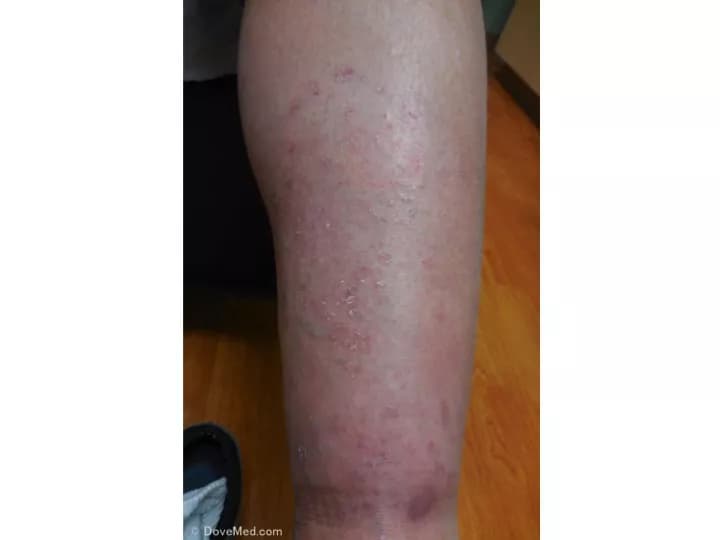What are the other Names for this Condition? (Also known as/Synonyms)
- Eosinophilic Cellulitis
- Granulomatous Dermatitis with Eosinophilia
- Well’s Syndrome
What is Familial Eosinophilic Cellulitis? (Definition/Background Information)
- Familial Eosinophilic Cellulitis is a rare skin disorder characterized by raised, red, itchy eruptions on the skin, accompanied by severe pain. It is usually observed on the lower arms or legs
- The exact cause of the disorder is unknown, but bites/stings of spider, bees, mites, fleas, and ticks are believed to be associated with this disorder
- Treatment involves topical application of steroids, calcineurin inhibitors, antihistamines, and antifungal medications
- Familial Eosinophilic Cellulitis has a very good prognosis with no long-term complications being generally observed
Who gets Familial Eosinophilic Cellulitis? (Age and Sex Distribution)
- Familial Eosinophilic Cellulitis is a very rare skin disorder. Worldwide, fewer than 100 cases have been reported
- The disorder usually affects adults, though some cases have also been reported in children
- Both men and women are affected in equal proportions (based on the cases identified and studied)
- No ethnic, racial, or geographical predominance has been noted
What are the Risk Factors for Familial Eosinophilic Cellulitis? (Predisposing Factors)
The risk factors associated with Familial Eosinophilic Cellulitis include:
- Bites and stings of arthropods (invertebrates with external skeleton, segmented body, and jointed appendages, which also includes insects and arachnids)
- Viral, parasitic, and fungal infections of the skin
- Leukemia: A type of blood cancer
- Myeloproliferative disorders: Conditions characterized by abnormal growth of blood cells
- Atopic dermatitis: An inflammatory, non-contagious, itchy skin disorder
- Hypersensitivity of the skin to certain medicines or to metals including alloys
- Churg-Strauss syndrome: A medical condition which affects the small and medium sized arteries and veins
It is important to note that having a risk factor does not mean that one will get the condition. A risk factor increases ones chances of getting a condition compared to an individual without the risk factors. Some risk factors are more important than others.
Also, not having a risk factor does not mean that an individual will not get the condition. It is always important to discuss the effect of risk factors with your healthcare provider.
What are the Causes of Familial Eosinophilic Cellulitis? (Etiology)
- The exact cause of development of Familial Eosinophilic Cellulitis is presently unknown
- It is usually sporadic (occurring randomly), but some familial cases (passed down families) have also been described
- Certain risk factors, such as insect bites, infections, or malignancies, can increase one’s risk for the condition
Some researchers believe that Familial Eosinophilic Cellulitis may be caused by an autoimmune disorder, which means that body’s natural defenses abnormally begin to attack one’s own healthy tissues.
What are the Signs and Symptoms of Familial Eosinophilic Cellulitis?
The signs and symptoms of Familial Eosinophilic Cellulitis may include:
- Burning, itching, and redness of the skin
- Edema: Swelling caused by abnormal accumulation of fluids in the body tissues
- Appearance of popular and nodular eruptions
- Vesicles: Small fluid-filled sacs on the skin
- Bullae: Large blisters on the skin filled with fluid
Systemic signs and symptoms that are rare but may include:
- Asthma
- Arthralgia (joint pain)
- Fever
How is Familial Eosinophilic Cellulitis Diagnosed?
The diagnosis of Familial Eosinophilic Cellulitis may include:
- A thorough physical examination along with a complete evaluation of medical history
- Skin biopsy: Cells and tissues are examined by a pathologist under the microscope
Pathological examination is generally considered to be a “gold standard” for a definitive diagnosis in this condition. The pathologist arrives at a diagnosis after analyzing pathology findings along with clinical information of the patient. Special studies may be performed on the tissue sample, to aid in the final diagnosis.
- Peripheral blood test: An increase in ECP (eosinophil cation protein) and IL-5 levels can be correlated with the severity of the disease
- Other investigative procedures may be necessary to detect an underlying condition/disorder
Many clinical conditions may have similar signs and symptoms. Your healthcare provider may perform additional tests to rule out other clinical conditions to arrive at a definitive diagnosis.
What are the possible Complications of Familial Eosinophilic Cellulitis?
Familial Eosinophilic Cellulitis does not lead to long-term complications. Nevertheless, a few associated complications are:
- Skin lesions that cause cosmetic issues
- Joint pain
- Recurrence of the condition following treatment
- Complications that may arise from any underlying condition, if any present
How is Familial Eosinophilic Cellulitis Treated?
Numerous treatment medications (including some that are applied topically on the skin lesions) are available for the management of Familial Eosinophilic Cellulitis. These include:
- Corticosteroids
- Calcineurin inhibitors
- Antifungals such as Griseofulvin
- Antimalarials such as hydroxychloroquine or chloroquine
- Immunosuppressants such as cyclosporine
- Antibiotics such as dapsone or minocycline
- Histamine (H1) receptor antagonists such as cyproheptadine, diphenhydramine, chlorpheniramine, and hydroxyzine hydrochloride
- Systemic corticosteroids are generally very effective, but it may lead to over-dependence on corticosteroids.
How can Familial Eosinophilic Cellulitis be Prevented?
As the exact cause of Familial Eosinophilic Cellulitis is yet to be determined, preventive measures are currently unavailable.
What is the Prognosis of Familial Eosinophilic Cellulitis? (Outcomes/Resolutions)
- The prognosis of Familial Eosinophilic Cellulitis is generally excellent
- It can resolve in a few weeks or months without long-term defects such as scarring of skin
- In very rare cases, the disorder can recur, in which case it may take a longer period to resolve completely
Additional and Relevant Useful Information for Familial Eosinophilic Cellulitis:
George Wells, in 1971, described Familial Eosinophilic Cellulitis as Recurrent Granulomatous Dermatitis with Eosinophilia. Wells and Smith then renamed it Eosinophilic Cellulitis in 1979.
Related Articles
Test Your Knowledge
Asked by users
Related Centers
Related Specialties
Related Physicians
Related Procedures
Related Resources
Join DoveHubs
and connect with fellow professionals



0 Comments
Please log in to post a comment.